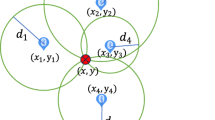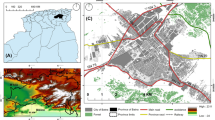Abstract
Wireless Underground Networks comprise the ability to constantly monitor several physical parameters such as ground temperature, water level and soil condition, and these are required to know the underground surface. A major challenge in wireless underground sensor networks is limited coverage area, high deployment costs, complex network topology, and identifying the better position for node deployment. To overcome these challenges, this research design an effective approach of localization algorithm that detects the location of unknown node position and then it must be able to place optimally to provide extended signal strength and coverage. The proposed design consists of three phases: placement selection using RSSI, placement selection using maximum signal strength and coverage, and predicting location. The proposed model provides an optimal solution to solve localization issues using a metaheuristic optimization algorithm in Long Range Topology based sensor network. The proposed model is implemented in MATLAB environment provides 84% of accuracy, 16% of error values and local delay, localization time, path loss, Mean Square Error, RSSI simulation, number of transmitted packets also obtained, this reveals the effectiveness of the proposed model.











Similar content being viewed by others
Abbreviations
- \({P}_{r}\) :
-
The receiver power
- \({P}_{t}\) :
-
Transmitter power
- \({G}_{t}\), \({G}_{r}\) :
-
Gains of the transmitter and receiver antenna
- \({L}_{0}\) :
-
Denotes path loss of wave propagation
- \(f\) :
-
Represents operating frequency
- \({L}_{s}\) :
-
Represents the extra path loss
- \(d\) :
-
The distance between receiver and transmitter
- \({d}_{0}\) :
-
Termed as a reference distance
- \(n\) :
-
Epresents signal propagation constant
- a,m,c:
-
Coefficient vectors
- m:
-
Confusing vector
- \({r}_{1}\),\({r}_{2}\) :
-
The Random vectors
- \({c}_{1},{c}_{2},{c}_{3}\),\({c}_{4}\) :
-
Dynamic coefficients
- \({m}_{1}, {m}_{2}, {m}_{3} ,{m}_{4}\),\(a1,a2,a3 ,a4\) :
-
Coefficients in the ChoA algorithm
- \({x}_{1}, {x}_{2},{x}_{3} and {x}_{4}\) and \({X}_{b}\) :
-
Current position
- \(i\) :
-
The actual location of the node
References
Branch, P., Li, B., & Zhao, K. (2020). A LoRa-based linear sensor network for location data in underground mining. Telecom, 1(2), 68–79.
Pandey, O. J., Gautam, V., Jha, S., Shukla, M. K., & Hegde, R. M. (2020). Time synchronized node localization using optimal H-node allocation in a small world WSN. IEEE Communications Letters, 24(11), 2579–2583.
Ayadi, A., Ghorbel, O., BenSalah, M. S., & Abid, M. (2020). Spatio-temporal correlations for damages identification and localization in water pipeline systems based on WSNs. Computer Networks, 171, 107134.
Vaquero, T. S., da Silva, M. S., Otsu, K., Kaufmann, M., Edlund, J. A., & Agha-mohammadi, A. A. (2020). Traversability-aware signal coverage planning for communication node deployment in planetary cave exploration. In The International Symposium on Artificial Intelligence, Robotics and Automation in Space (i-SAIRAS).
Laclau, P., Tempez, V., Ruffier, F., Natalizio, E., & Mouret, J. B. (2021). Signal-based self-organization of a chain of UAVs for subterranean exploration. Frontiers in Robotics and AI, 8, 46.
Bhat, S. J., & Venkata, S. K. (2020). An optimization based localization with area minimization for heterogeneous wireless sensor networks in anisotropic fields. Computer Networks, 179, 107371.
Deng, F., Zuo, P., Wen, K., & Wu, X. (2020). Novel soil environment monitoring system based on RFID sensor and LoRa. Computers and Electronics in Agriculture, 169, 105169.
Kevin, I., Wang, K., Wu, S., Ivoghlian, A., Salcic, Z., Austin, A., & Zhou, X. (2019, August). LWS: A LoRaWAN wireless underground sensor network simulator for agriculture applications. In 2019 IEEE SmartWorld, Ubiquitous Intelligence & Computing, Advanced & Trusted Computing, Scalable Computing & Communications, Cloud & Big Data Computing, Internet of People and Smart City Innovation (SmartWorld/SCALCOM/UIC/ATC/CBDCom/IOP/SCI) (pp. 475–482). IEEE.
Khishe, M., & Mosavi, M. R. (2020). Classification of underwater acoustical dataset using neural network trained by chimp optimization algorithm. Applied Acoustics, 157, 107005.
Khattak, S., Nguyen, H., Mascarich, F., Dang, T., & Alexis, K. (2020, September). Complementary multi–modal sensor fusion for resilient robot pose estimation in subterranean environments. In 2020 International Conference on Unmanned Aircraft Systems (ICUAS) (pp. 1024–1029). IEEE.
Ge, B., Wang, K., Han, J., & Zhao, B. (2015). Improved rssi positioning algorithm for coal mine underground locomotive. Journal of Electrical and Computer Engineering, 2015, 1–8.
Fakhrey, H., Tiwari, R., Johnston, M., & Al-Mathehaji, Y. A. (2016). The optimum design of location-dependent key management protocol for a WSN with a random selected cell reporter. IEEE Sensors Journal, 16(19), 7217–7226.
Guo, Q., & Kluse, C. (2020). A framework of photovoltaics recycling facility location optimization. Sustainable Production and Consumption, 23, 105–110.
Huang, H., Shi, J., Wang, F., Zhang, D., & Zhang, D. (2020). Theoretical and experimental studies on the signal propagation in soil for wireless underground sensor networks. Sensors, 20(9), 2580.
Dang, T., Tranzatto, M., Khattak, S., Mascarich, F., Alexis, K., & Hutter, M. (2020). Graph-based subterranean exploration path planning using aerial and legged robots. Journal of Field Robotics, 37(8), 1363–1388.
Xiaoya, H., Chao, G., Bingwen, W., & Wei, X. (2011). Channel modeling for wireless underground sensor networks. In 2011 IEEE 35th Annual Computer Software and Applications Conference Workshops (pp. 249–254). IEEE.
Alablani, I., & Alenazi, M. (2020). EDTD-SC: An IoT sensor deployment strategy for smart cities. Sensors, 20(24), 7191.
Rama, P., & Murugan, S. (2020). Localization approach for tracking the mobile nodes using FA based ANN in subterranean wireless sensor networks. Neural Processing Letters, 51(2), 1145–1164.
Lin, K., & Hao, T. (2020). Experimental link quality analysis for LoRa-based wireless underground sensor networks. IEEE Internet of Things Journal, 8(8), 6565–6577.
Wu, S., Austin, A. C., Ivoghlian, A., Bisht, A., Kevin, I., & Wang, K. (2020). Long range wide area network for agricultural wireless underground sensor networks. Journal of Ambient Intelligence and Humanized Computing, 2020, 1–17.
Tam, N. T., Dung, D. A., Hung, T. H., Binh, H. T. T., & Yu, S. (2020). Exploiting relay nodes for maximizing wireless underground sensor network lifetime. Applied Intelligence, 50(12), 4568–4585.
Ebi, C., Schaltegger, F., Rüst, A., & Blumensaat, F. (2019). Synchronous LoRa mesh network to monitor processes in underground infrastructure. IEEE Access, 7, 57663–57677.
Banaseka, F. K., Katsriku, F., Abdulai, J. D., Adu-Manu, K. S., & Engmann, F. N. A. (2021). Signal propagation models in soil medium for the study of wireless underground sensor networks: a review of current trends. Wireless Communications and Mobile Computing, 2021, 1–12.
Funding
No funding received for this research.
Author information
Authors and Affiliations
Corresponding author
Ethics declarations
Conflict of interest
The process of writing and the content of the article does not give grounds for raising the issue.
Ethical Approval
This article is a completely original work of its authors; it has not been published before and will not be sent to other publications until the WPC editorial board make its decision.
Additional information
Publisher's Note
Springer Nature remains neutral with regard to jurisdictional claims in published maps and institutional affiliations.
Rights and permissions
About this article
Cite this article
Syed Ali Fathima, S.J., Lalitha, T., Ahmad, F. et al. Unital Design Based Location Service for Subterranean Network Using Long Range Topology. Wireless Pers Commun 124, 1815–1839 (2022). https://doi.org/10.1007/s11277-021-09432-w
Accepted:
Published:
Issue Date:
DOI: https://doi.org/10.1007/s11277-021-09432-w




